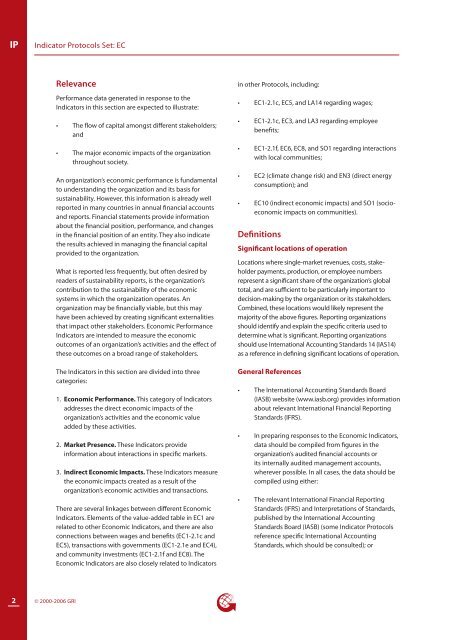Indicator Protocols Set Economic (EC) - Global Reporting Initiative
Indicator Protocols Set Economic (EC) - Global Reporting Initiative
Indicator Protocols Set Economic (EC) - Global Reporting Initiative
You also want an ePaper? Increase the reach of your titles
YUMPU automatically turns print PDFs into web optimized ePapers that Google loves.
IP<br />
<strong>Indicator</strong> <strong>Protocols</strong> <strong>Set</strong>: <strong>EC</strong><br />
Relevance<br />
Performance data generated in response to the<br />
<strong>Indicator</strong>s in this section are expected to illustrate:<br />
• The flow of capital amongst different stakeholders;<br />
and<br />
• The major economic impacts of the organization<br />
throughout society.<br />
An organization’s economic performance is fundamental<br />
to understanding the organization and its basis for<br />
sustainability. However, this information is already well<br />
reported in many countries in annual financial accounts<br />
and reports. Financial statements provide information<br />
about the financial position, performance, and changes<br />
in the financial position of an entity. They also indicate<br />
the results achieved in managing the financial capital<br />
provided to the organization.<br />
What is reported less frequently, but often desired by<br />
readers of sustainability reports, is the organization’s<br />
contribution to the sustainability of the economic<br />
systems in which the organization operates. An<br />
organization may be financially viable, but this may<br />
have been achieved by creating significant externalities<br />
that impact other stakeholders. <strong>Economic</strong> Performance<br />
<strong>Indicator</strong>s are intended to measure the economic<br />
outcomes of an organization’s activities and the effect of<br />
these outcomes on a broad range of stakeholders.<br />
The <strong>Indicator</strong>s in this section are divided into three<br />
categories:<br />
1. <strong>Economic</strong> Performance. This category of <strong>Indicator</strong>s<br />
addresses the direct economic impacts of the<br />
organization’s activities and the economic value<br />
added by these activities.<br />
2. Market Presence. These <strong>Indicator</strong>s provide<br />
information about interactions in specific markets.<br />
3. Indirect <strong>Economic</strong> Impacts. These <strong>Indicator</strong>s measure<br />
the economic impacts created as a result of the<br />
organization’s economic activities and transactions.<br />
There are several linkages between different <strong>Economic</strong><br />
<strong>Indicator</strong>s. Elements of the value-added table in <strong>EC</strong>1 are<br />
related to other <strong>Economic</strong> <strong>Indicator</strong>s, and there are also<br />
connections between wages and benefits (<strong>EC</strong>1-2.1c and<br />
<strong>EC</strong>5), transactions with governments (<strong>EC</strong>1-2.1e and <strong>EC</strong>4),<br />
and community investments (<strong>EC</strong>1-2.1f and <strong>EC</strong>8). The<br />
<strong>Economic</strong> <strong>Indicator</strong>s are also closely related to <strong>Indicator</strong>s<br />
in other <strong>Protocols</strong>, including:<br />
• <strong>EC</strong>1-2.1c, <strong>EC</strong>5, and LA14 regarding wages;<br />
• <strong>EC</strong>1-2.1c, <strong>EC</strong>3, and LA3 regarding employee<br />
benefits;<br />
• <strong>EC</strong>1-2.1f, <strong>EC</strong>6, <strong>EC</strong>8, and SO1 regarding interactions<br />
with local communities;<br />
• <strong>EC</strong>2 (climate change risk) and EN3 (direct energy<br />
consumption); and<br />
• <strong>EC</strong>10 (indirect economic impacts) and SO1 (socioeconomic<br />
impacts on communities).<br />
Definitions<br />
Significant locations of operation<br />
Locations where single-market revenues, costs, stakeholder<br />
payments, production, or employee numbers<br />
represent a significant share of the organization’s global<br />
total, and are sufficient to be particularly important to<br />
decision-making by the organization or its stakeholders.<br />
Combined, these locations would likely represent the<br />
majority of the above figures. <strong>Reporting</strong> organizations<br />
should identify and explain the specific criteria used to<br />
determine what is significant. <strong>Reporting</strong> organizations<br />
should use International Accounting Standards 14 (IAS14)<br />
as a reference in defining significant locations of operation.<br />
General References<br />
• The International Accounting Standards Board<br />
(IASB) website (www.iasb.org) provides information<br />
about relevant International Financial <strong>Reporting</strong><br />
Standards (IFRS).<br />
• In preparing responses to the <strong>Economic</strong> <strong>Indicator</strong>s,<br />
data should be compiled from figures in the<br />
organization’s audited financial accounts or<br />
its internally audited management accounts,<br />
wherever possible. In all cases, the data should be<br />
compiled using either:<br />
• The relevant International Financial <strong>Reporting</strong><br />
Standards (IFRS) and Interpretations of Standards,<br />
published by the International Accounting<br />
Standards Board (IASB) (some <strong>Indicator</strong> <strong>Protocols</strong><br />
reference specific International Accounting<br />
Standards, which should be consulted); or<br />
2<br />
© 2000-2006 GRI

















